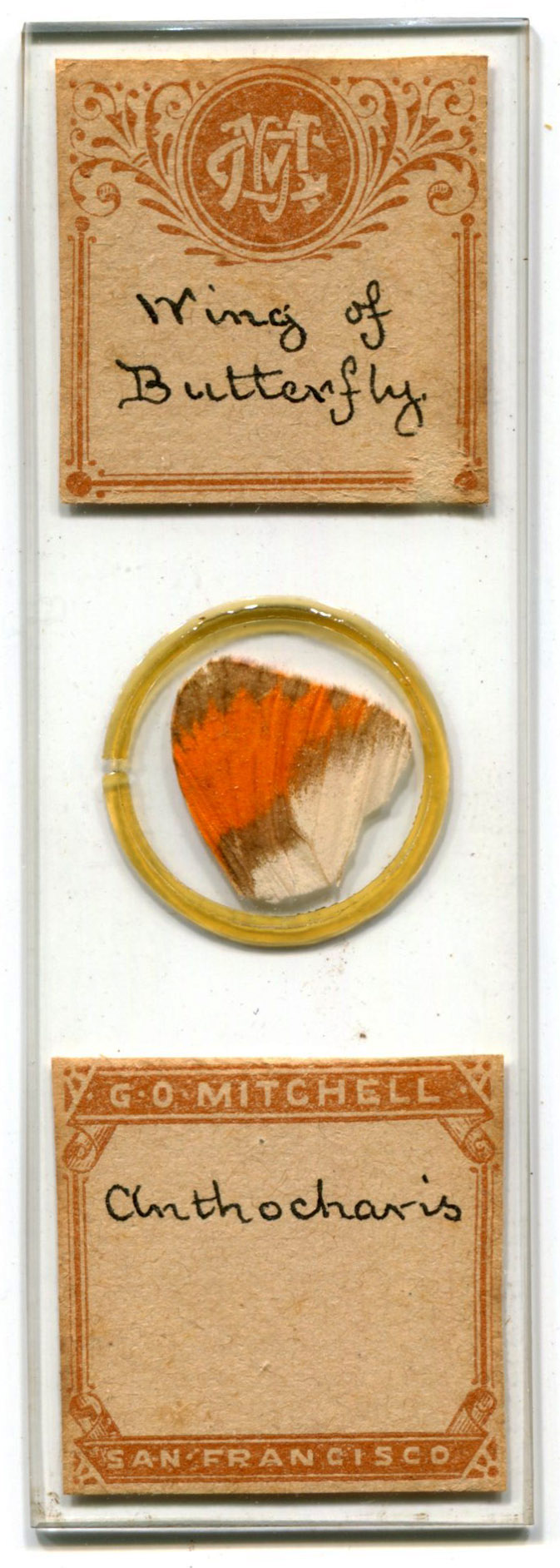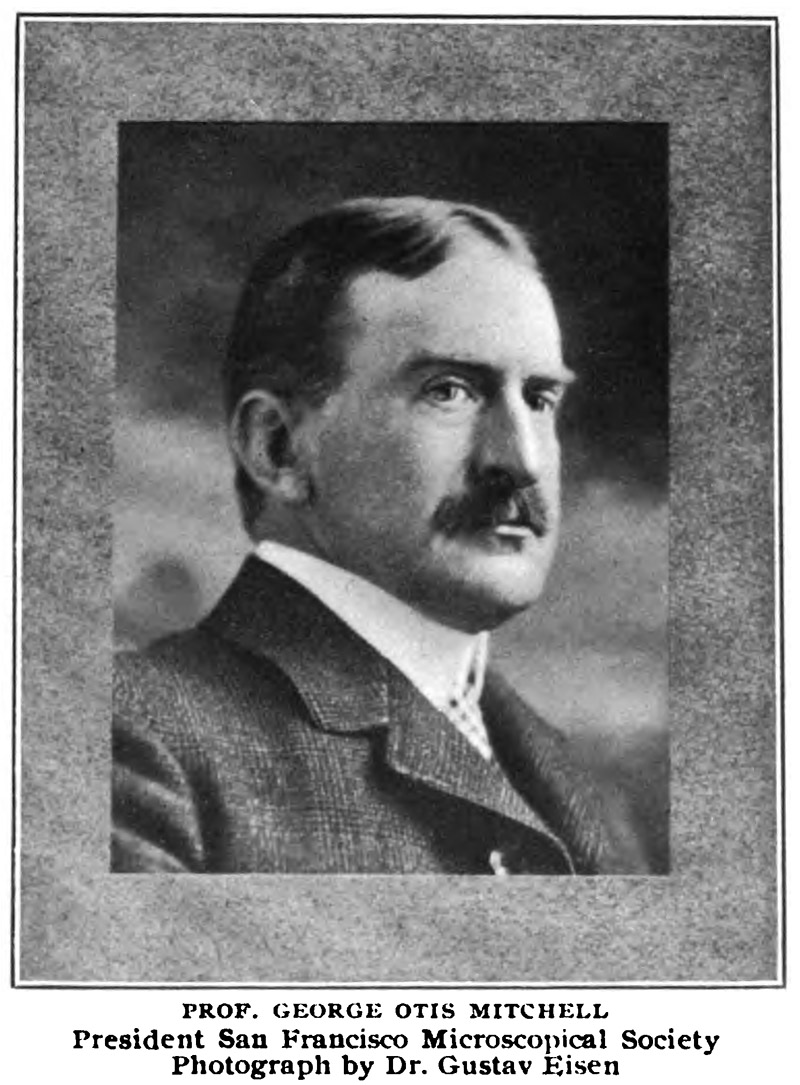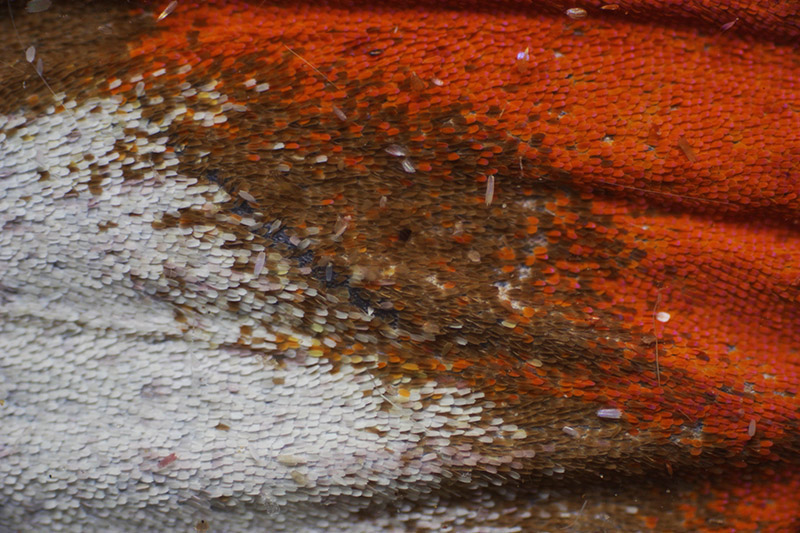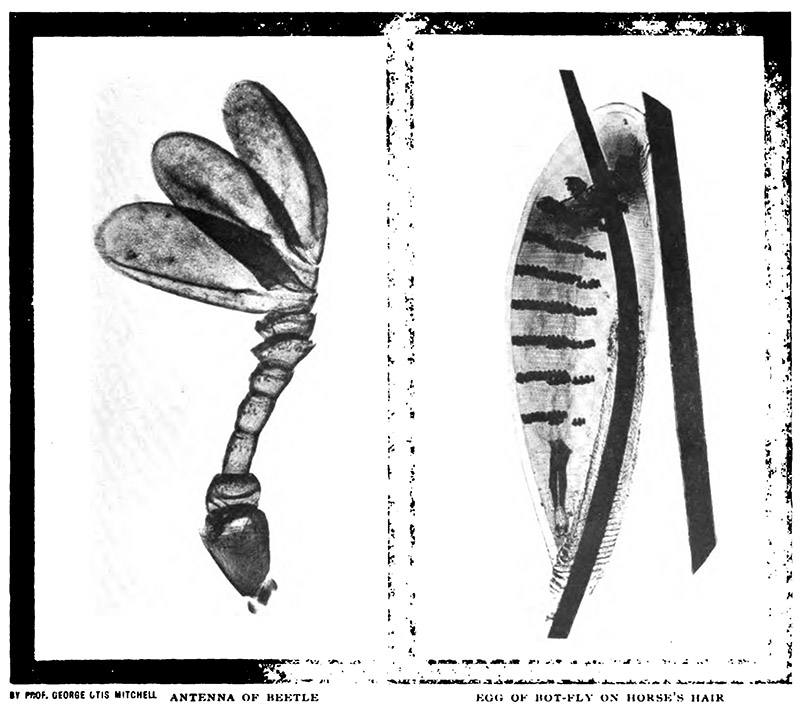
Figure 1. Dry mounted tip of the front wing of an Anthocharis spp. butterfly.
George Otis Mitchell, 1859-1913
by Brian Stevenson
last updated April, 2016
G.O. Mitchell’s microscope slides are relatively scarce at this time. However, he was an active amateur microscopist from the early 1880s onward, exhibited numerous mounts of many different types of specimens, and made public offers to exchange slides, so it is likely that a substantial number of Mitchell slides still exist.

Figure 1.
Dry mounted tip of the front wing of an Anthocharis spp. butterfly.

Figure 2.
Charles Otis Mitchell, circa 1901. Adapted from his article on photomicrography that appeared in “Camera Craft”.
George Otis Mitchell was born on February 20, 1859, in Bath Maine, USA. He was third child, and the second son, of Edward and Frances Mitchell. The 1860 census listed Edward as being a “ship master”, owning real estate of $5200.
G.O. Mitchel attended Dartmouth College, New Hampshire. He graduated in 1880 with an A.B. in Teaching.
In 1884, Mitchell published a paper on production of photomicrographs, indicating that he was then proficient in both microscopy and photography. He published another paper on photomicrography in 1901, accompanied by several examples of his work. Two are reproduced here as Figure 4.
Mitchell lived in San Francisco by 1890. The 1890 California voter lists listed him as living at 712 Sutter Street, and working as a “teacher”. He taught “science” at the San Francisco Girls’ High School, and also served as Assistant Principal from the late 1890s onward.
He was very active in the San Francisco Microscopical Society. Mitchell served as Society Secretary through the 1890s, and President in the 1900s. Additional offices were served, including this from 1892, “G.O. Mitchell, for the Committee on the Workroom, reported what that committee had done in fitting up a dark room for photo-micrography and in furnishing abundant facilities for the members to work in preparing and mounting objects”.
Cassino’s 1895 Naturalists' Universal Directory listed Mitchell at “1817 1/2 Pine St., San Francisco”, where he lived throughout the rest of his life. The Directory also noted that Mitchell offered “Lists furnished and solicited”. That implies that Mitchell produced a substantial number of microscope slides for exchanges. Consistent with that idea, the butterfly wing illustrated in Figure 1 was acquired in a case of slides that had been owned by a New York-area microscopist.
In 1893, the Royal Microscopical Society, “received a letter … from Mr. G.O. Mitchell, Corresponding Secretary of the San Francisco Microscopical Society, stating that he had sent with it a quantity of diatomaceous earth from Los Angeles in California. This would also be placed in the Library at the disposal of any Fellows of the Society who might wish to take some home for examination”. Mitchell’s obituaries indicated that he was a Fellow of the Royal Microscopical Society. I have not identified the date when he joined that Society.
Mitchell was responsible for one of the first uses of wireless transmission of news in the Americas, in 1899. The transport ship Sherman was returning to San Francisco, filled with Californian troops, so the city wanted to present a big celebration at the arrival. But, nobody knew when the ship would arrive. Mitchell was familiar with wireless telegraphy, and suggested that a transmitter be installed on an offshore lightship. When the Sherman passed the lightship on its way into San Francisco, a crewman on the lightship radioed notification to a receiver in the city. The alerted city turned out to welcome their soldiers home.
George Mitchell passed away in San Francisco on June 25, 1913. He had not married.

Figure 3.
Magnified view of Mitchell’s mount of a Anthocharis butterfly wing.

Figure 4.
Two 1901 photomicrographs by G.O. Mitchell. Left, “Antenna of Beetle”. Right, “Egg of Bot-Fly on Horse’s Hair”.
Resources
Addresses of Living Graduates of Dartmouth College (1906) page 33
American Monthly Microscopical Journal (1892) Microscopical societies: San Francisco, Vol. 13, pages 104 and 175
Atlantic Transport Line: SS Mobile (accessed April, 2016) http://www.atlantictransportline.us/content/21Mobile.htm
The Bulletin (1913) “Mitchell - In this city, June 25, George Otis Mitchell, brother of Edward P. and Mary Mitchell, a native of Bath, Maine, aged 54 years 4 months and 6 days”, accessed through http://boards.ancestry.com/surnames.mitchell/10992/mb.ashx
Dartmouth College Necrology, 1912-1913, “Class of 1880 - George Otis Mitchell. BK. B. Feb. 20, 1859, Bath, Maine. Fellow Royal Microsc. Soc. Gt. Britain. Teacher. D. June 25, 1913, San Francisco, Cal.”, Dartmouth College, Hanover, N.H., accessed through http://genealogytrails.com/cal/sfranc/obits/obit4.html
Journal of the Royal Microscopical Society (1893) page 281
Mitchell, George Otis (1884) A focussing glass for photo-micrography, American Monthly Microscopical Journal, Vol. 5, page 81
Mitchell, George Otis (1901) Photo-micrography with low powers, Camera Craft, Vol. 3, pages 36-39
The Naturalists' Universal Directory (1895) S.E. Cassino, Boston, page 134
San Francisco Call (1910) “Youth attempts to burn school, Lad starts blaze in Hamilton Grammar which is put out by teacher, Timely intervention of passing pedagogue saves building from destruction, Probably figuring that the destruction of the school house would insure a prolonged vacation, an unknown boy about 16 years old set fire to the Hamilton grammar school, Geary and Scott streets, yesterday afternoon. Through the timely intervention of G.O. Mitchell of 1857 Pine street, a teacher in the Girls’ high school, the flames were extinguished. Mitchell was passing the Hamilton school about 1:30 p.m., when he noticed a boy corning out. Something In the actions of the youth led him to believe that all was not right. His inquiry as to why he had been in the building was met with the ready explanation that he was after his baseball. A boy threw it through the window. said the lad. The explanation did not satisfy, Mitchell, who, bidding the boy wait, went into the school to make an examination. He found that the boy had set fire to a pile of papers in the corner of a room on the ground floor. The flames had spread to the walls and blackboards and Mitchell had a hard fight to put them out. While he was fighting the fire the boy made good his escape. The matter was reported by Mitchell to the police. Detectives were detailed on the case, but at a late hour the boy had not been found”, Vol. 107, Number 48, January 17, page 5
U.S. census, voter registration, birth, and other records, accessed through ancestry.com